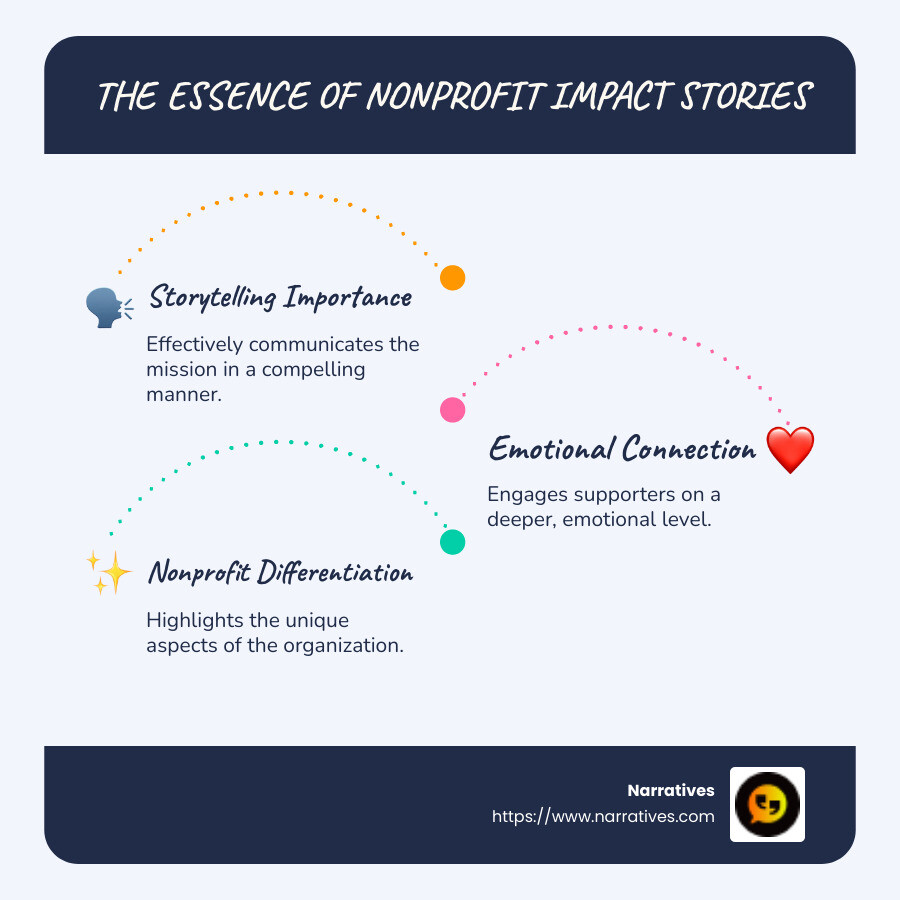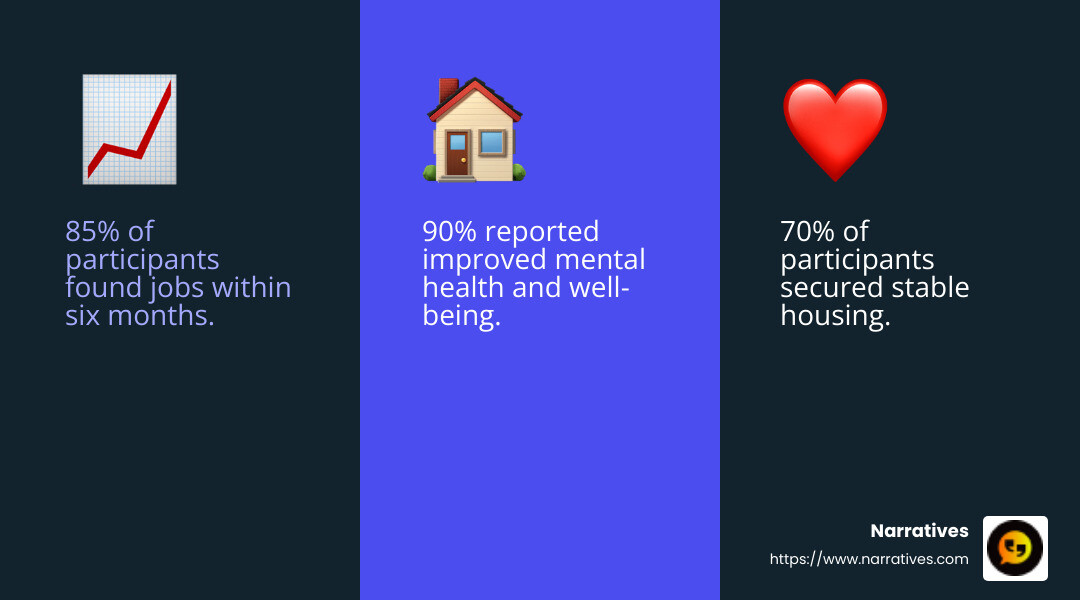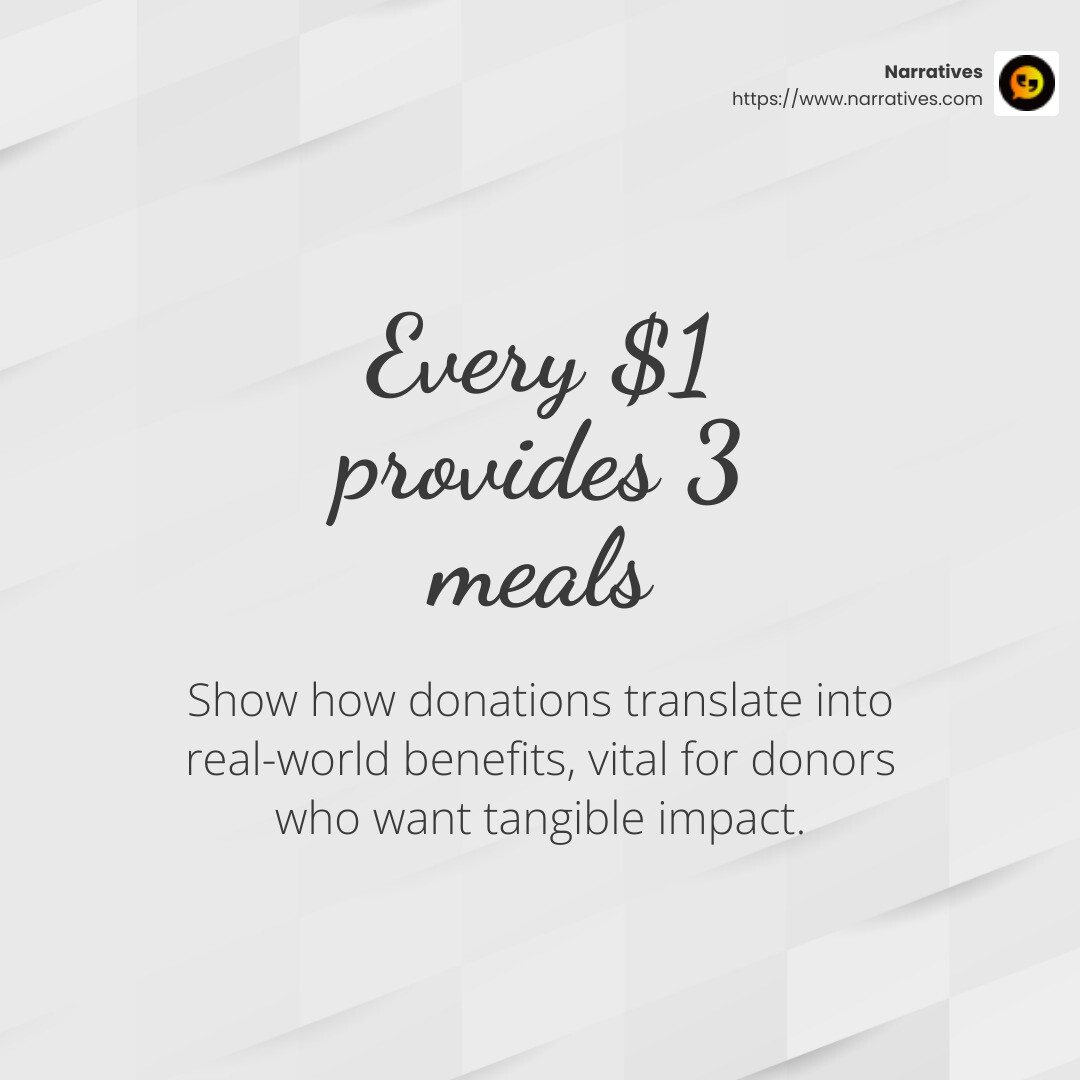The Power of Narrative: Elevating Nonprofit Impact Through Storytelling

Nonprofit impact stories are the heartbeats of organizations dedicated to making a difference. At their core, these narratives do more than just inform—they engage, inspire, and connect. For those wondering why storytelling matters for nonprofits, here's a quick breakdown:
- Storytelling Importance: Communicates the mission compellingly.
- Emotional Connection: Engages supporters on a deeper level.
- Nonprofit Differentiation: Highlights unique aspects of an organization.
In the crowded landscape of charitable causes, the power of storytelling is best. An impactful story turns statistics and strategies into human experience, drawing on the deep reserves of empathy within us all. As narrated by August Turek, change stories highlight the profound changes organizations can foster—from satisfying simple needs to achieving personal growth.
Stories act as a bridge, allowing people to connect with a charitable cause on a personal level. Just as a photograph can pull at your heartstrings, a well-told story can galvanize action and support.
Consider how Sharon's journey at a charity unveils a tale of hope and redemption. Such stories not only differentiate a nonprofit from numerous others but also invite the audience to play an active role in the narrative, making every recipient a guide of potential.
By sharing these resonating changes, nonprofits aren't just telling stories—they're inviting collaboration in a journey that transforms both the giver and receiver.

Understanding Nonprofit Impact Stories
Nonprofit impact stories are powerful tools that showcase real narratives involving actual people. They combine anecdotal evidence with quantitative data to paint a full picture of an organization's impact.
Real Narrative and Actual People
At the heart of every impactful nonprofit story is a real narrative. This isn't just about statistics or abstract ideas; it's about real people and their experiences. For example, consider a nonprofit working with homeless veterans. Instead of merely stating how many people they helped, they might share the story of a veteran who found stable housing and employment through their program. This individual's story makes the impact tangible and relatable.
Why focus on actual people? Because stories about individuals resonate more deeply with audiences than generalized data about large groups. A single person's journey can illustrate the broader mission of the organization in a way that numbers alone cannot.
Anecdotal Evidence
Anecdotal evidence adds depth to these stories. It involves sharing personal experiences and testimonials that highlight the nonprofit's impact. For instance, a nonprofit might include a quote from a beneficiary describing how their life changed due to the organization's efforts. These personal touches make the story more engaging and memorable.
"Before joining the program, I felt lost. Now, I have hope for the future," says a participant in a youth mentorship initiative.
Quantitative Data
While stories of individuals are compelling, they need to be supported by quantitative data to show the broader impact. Numbers provide credibility and context to the narrative. For instance, if a nonprofit reports that 85% of their program participants found jobs within six months, it underscores the effectiveness of their efforts.

Balancing anecdotes with data is crucial. The combination of personal stories and hard facts creates a comprehensive and persuasive narrative that appeals to both the heart and the mind.
In summary, nonprofit impact stories are a blend of real narratives, personal experiences, and solid data. They humanize the work of nonprofits, making it easier for audiences to connect and take action. These stories are not just about what was done, but about the lives that were transformed along the way.
Crafting Compelling Nonprofit Impact Stories
Creating a nonprofit impact story that truly resonates requires a clear voice, a thoughtful storytelling plan, and the ability to humanize data. Let's explore these key elements.
Clear Voice
A clear voice is essential when telling your nonprofit's story. It sets the tone and ensures consistency across all platforms. Think of it as your organization's personality. Are you warm and friendly? Or perhaps more formal and authoritative? Whatever the tone, it should align with your mission and audience.
Consistency is key. Whether you're writing a blog post, creating a video, or posting on social media, your voice should remain steady. This helps build trust and makes your nonprofit more recognizable.
Storytelling Plan
A storytelling plan is your roadmap. It outlines how you'll gather stories, what themes to focus on, and where to share them. Start by answering these questions:
- Who is your audience? Tailor your stories to their interests and concerns.
- What is the purpose? Are you trying to raise funds, increase awareness, or recruit volunteers?
- Which platform will you use? Different platforms require different formats and styles.
By having a plan, you can ensure your stories are strategic and purposeful. This structure helps in crafting narratives that not only inform but also inspire action.
Humanize Data
Data is powerful, but it can be dry and impersonal. To make it resonate, humanize it. This means weaving data into stories about real people and their experiences.
For example, if your nonprofit provides educational support to underprivileged children, don't just share numbers. Tell the story of a child whose life was changed by your program. Use their journey to illustrate the broader impact of your work.
Combine anecdotes with data. A story about a single child's success, supported by statistics on overall program effectiveness, creates a compelling narrative.
Social Return on Investment (ROI)
Nonprofits often focus on the social ROI rather than financial ROI. This means showing how donations and support translate into real-world benefits.
For example, a food bank might show that every dollar donated provides three meals to those in need. This type of information is crucial for donors who want to see the tangible impact of their contributions.

Communicating social ROI helps differentiate your nonprofit from others. It shows potential donors the value of their investment and encourages ongoing support.
By focusing on a clear voice, strategic storytelling, humanized data, and social ROI, you can craft nonprofit impact stories that are both engaging and effective. These stories don't just inform—they inspire.
The Role of Visuals in Nonprofit Storytelling
Visuals are the heart of compelling nonprofit impact stories. They transform data into emotional experiences and help audiences connect with your cause on a deeper level. Let's explore how photos and videos play a crucial role in storytelling.
Photos: A Thousand Words in One Frame
Photos have the power to convey complex emotions and stories without a single word. They humanize your cause, putting faces to the names and numbers that often dominate nonprofit reports. A well-chosen photo can highlight the joy of a family receiving support or the determination of a volunteer making a difference.
Think about the emotional effect. A photo of a child holding a new book can illustrate the impact of an educational program far better than statistics alone. These images stick with viewers, making your mission memorable.
Videos: Bringing Stories to Life
Videos take storytelling to the next level by combining visuals, sound, and narrative. They allow nonprofits to showcase their work in action, creating a dynamic and engaging experience for viewers.
Consider the emotional journey in a short video showing a day in the life of someone your organization has helped. This approach not only informs but also inspires viewers to take action, whether that's donating, volunteering, or spreading the word.
Visual storytelling is powerful. It's more than just showing what you do; it's about making people feel something. Videos can capture the essence of your mission and the real-world impact of your work.
Emotional Effect: Connecting on a Human Level
The true power of visuals lies in their ability to evoke emotions. People are more likely to remember and support causes that move them emotionally. According to research, stories are remembered up to 22 times more than facts alone.
Use visuals to create an emotional connection. Whether it's the relief on a parent's face when they receive support or the happiness of a community coming together, these moments resonate with your audience.
Visual Storytelling: A Strategic Tool
Incorporating visuals into your storytelling strategy is not just beneficial—it's essential. Photos and videos can be shared across multiple platforms, from social media to newsletters, amplifying your reach and impact.
Strategize your visual content. Think about what visuals best represent your mission and how they can be used to tell a cohesive story. Use them to highlight key moments, celebrate successes, and showcase the ongoing need for support.
By embracing the power of photos and videos, nonprofits can create nonprofit impact stories that are not only informative but also deeply moving. These visuals add depth to your narrative, helping your audience see and feel the difference you're making.
6 Reasons to Accept Nonprofit Storytelling
Storytelling is not just about sharing information; it's about making your work come alive. Here are six compelling reasons to accept storytelling in your nonprofit activities:
1. Humanizes Work
Nonprofit impact stories put a face to the numbers. They show the real people behind the statistics—those who benefit from your work and those who make it possible. When you tell a story about a person or a family helped by your organization, you're not just sharing data; you're sharing a piece of their life.
Example: A story about a local family overcoming food insecurity with help from a food pantry can be more impactful than a report on the number of meals served.
2. Empowers Advocates
Stories turn supporters into advocates. When people feel connected to a cause, they are more likely to spread the word and rally others. By sharing personal stories of change, you empower your supporters to become storytellers in their own right.
Use "you" language. Show supporters how they are a part of the story and how their involvement makes a difference.
3. Improves Transparency
Transparency builds trust. Donors want to know how their contributions are used and the impact they have. Storytelling provides a transparent view of your organization's journey, from challenges to successes.
Consider donor stories. When donors share why they support your cause, it serves as a testimonial that builds credibility and trust.
4. Inspires Action
Great stories move people to act. Whether it's donating, volunteering, or advocating, a well-told story can inspire your audience to take the next step. Nonprofit storytelling creates an emotional connection that makes people want to get involved.
Example: A video showing the change of a community due to your organization's efforts can inspire viewers to contribute to your cause.
5. Improves Emotional Connection
Stories stick with us because they evoke emotions. They make abstract concepts real and relatable. When people feel something, they remember it, and they are more likely to act on it.
Fact: According to research, stories are remembered up to 22 times more than facts alone.
6. Strengthens Community
Stories bring people together. They create a shared experience and a sense of belonging. By telling the stories of those you serve and those who serve with you, you build a community around your cause.
Use community stories. Highlight the contributions of volunteers, staff, and beneficiaries to show the collective effort behind your mission.
Embracing storytelling in your nonprofit work not only improves your message but also strengthens your impact. By making your stories relatable, transparent, and action-oriented, you can inspire others to join your cause and make a difference.
Frequently Asked Questions about Nonprofit Impact Stories
What is an impact story?
An impact story is more than just a report of what your nonprofit does—it's a powerful narrative that connects your audience emotionally to your mission. It uses real-life examples and personal anecdotes to illustrate the tangible effects your organization has on individuals and communities.
Think of it as a bridge. It connects the work you do with the hearts and minds of your supporters, making your mission relatable and inspiring action.
How to write an impact story?
Crafting an impact story involves a few key steps:
Identify Your Audience: Know who you're speaking to. Tailor your story to resonate with their values and interests.
Define the Purpose: What do you want your audience to feel or do after reading your story? Keep this goal in mind.
Find the Right Story: Look for stories that highlight your impact meaningfully. Choose a narrative that vividly illustrates the change your organization brings.
Structure Your Story: Use a clear beginning, middle, and end. Start with a compelling hook, describe the challenge, and show how your organization provided a solution.
Include Emotions and Facts: Balance emotional anecdotes with quantitative data to create a well-rounded narrative.
Call to Action: End with a clear call to action, encouraging your audience to support your cause.
Remember: Simple language and a clear structure make your story accessible and engaging.
Why are impact stories important?
Impact stories are vital for several reasons:
Emotional Connection: They create a personal bond between your audience and your mission. When people connect emotionally, they're more likely to support your cause.
Increased Engagement: Stories are engaging and memorable. They capture attention and hold it, making your message stick.
Improved Transparency: By sharing real stories, you provide a transparent view of your organization's work and impact, building trust with your audience.
Motivates Action: A well-told story can inspire your audience to donate, volunteer, or advocate for your cause.
Content Creation: They offer a rich source of content for newsletters, social media, and annual reports, keeping your communications fresh and engaging.
Nonprofit impact stories are a powerful tool that can lift your message and amplify your impact. They transform abstract missions into relatable and compelling narratives that inspire and mobilize support.
Conclusion
In nonprofit storytelling, Narratives stands out as a guide for elevating underrepresented voices and inspiring action through emotionally resonant content. Our focus is on crafting community-driven storytelling that not only tells a story but also builds a bridge between nonprofits and their audiences.
Lifting voices is at the core of what we do. By highlighting the real stories of individuals and communities, we aim to humanize the work of nonprofits. This approach ensures that the voices of those who are often unheard are amplified, creating a profound connection between your mission and your supporters.
Inspiring action is the ultimate goal. Through well-crafted narratives, we aim to motivate your audience to engage with your cause, whether it's through donations, volunteering, or advocacy. By weaving together personal anecdotes, powerful visuals, and actionable insights, we help your nonprofit not only tell its story but also drive real-world impact.
Explore how our storytelling expertise can lift your nonprofit's impact. Find our services and see how we can help you craft stories that resonate, inspire, and make a difference.


